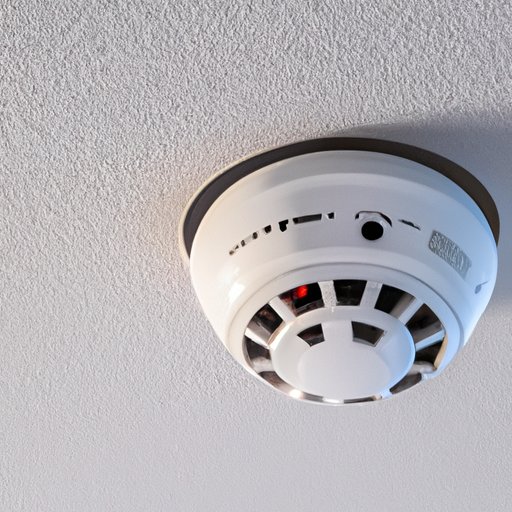Introduction
When it comes to protecting your home and family from fire hazards, smoke detectors are a must-have. These compact devices serve as early warning systems that can save your life and minimize property damage. In the event of a fire, smoke detectors sound an alarm that gives you crucial time to evacuate. However, not all smoke detectors are created equal. It’s important to know how many smoke detectors you need and where to install them for maximum home safety.
Why One Smoke Detector Is Not Enough: The Importance of Multiple Alarms in Your Home
Having just one smoke detector in your home is not enough to keep you safe from fire hazards. It’s important to have multiple alarms installed in various locations throughout your home. This ensures that no matter where a fire starts, you’ll have ample warning to evacuate. Ideally, there should be at least one smoke detector on each level of your home, including the basement.
It’s also important to have interconnected smoke detectors. Interconnected smoke detectors are wired together so that when one detector sounds an alarm, all of the other detectors in the network will sound an alarm as well. This feature has several benefits, including:
- Providing a clear warning to all occupants of the home
- Ensuring maximum coverage in the event of a fire
- Reducing the chance of false alarms
- Increasing the chances of detecting a fire in its early stages
The ABCs of Smoke Detectors: Assessing Your Needs and Budget
There are three main types of smoke detectors available on the market: ionization smoke detectors, photoelectric smoke detectors, and dual-sensor smoke detectors. Ionization smoke detectors are better at detecting flames, while photoelectric smoke detectors are better at detecting smoldering fires. Dual-sensor smoke detectors combine both technologies for maximum coverage.
When choosing the right smoke detector for your home, there are several factors to consider, including your budget, the number of occupants in your home, the number of rooms, and the size of your home. Keep in mind that while ionization smoke detectors are cheaper, photoelectric and dual-sensor smoke detectors are more effective at detecting smoldering fires, which are responsible for the majority of fire deaths.

Smoke Detectors 101: Understanding Industry Standards and Codes
The smoke detectors you choose for your home must comply with industry standards and codes set by the National Fire Protection Association (NFPA) and the International Association of Fire Fighters (IAFF). These standards and codes ensure that smoke detectors are effective and safe.
According to the NFPA, smoke detectors should be installed inside each bedroom, outside each sleeping area, and on every level of the home, including the basement. They should be interconnected and tested regularly. Additionally, smoke detectors should be replaced every 10 years, regardless of their functionality.
DIY Tips for Installing Smoke Detectors in Your Home
Installing smoke detectors in your home is a DIY project that can be easily accomplished with a few basic tools. Follow these steps to properly install smoke detectors in your home:
- Choose the right smoke detector for your needs and budget.
- Read the manufacturer’s instructions carefully.
- Choose the best location for your smoke detector.
- Use a pencil to mark the spot where you will install the smoke detector.
- Use a drill to create a hole in the ceiling or wall.
- Attach the mounting bracket to the ceiling or wall using screws.
- Clip the smoke detector onto the mounting bracket.
- Test the smoke detector to ensure that it’s working properly.
When installing your smoke detectors, be sure to avoid common mistakes, such as installing them too close to air vents or ceiling fans, or near sources of steam, smoke, or cooking fumes.
The Benefits of Interconnected Smoke Detectors: Protecting Your Family Against Fire Hazards
Interconnected smoke detectors are a must-have for maximum home safety. These smoke detectors are wired together so that when one smoke detector sounds an alarm, all the others in the network will sound an alarm as well. This feature provides several benefits, including:
- Ensuring that all occupants of the home receive ample warning in the event of a fire
- Reducing the incidence of false alarms
- Increasing the chances of detecting a fire in its early stages
The Hidden Dangers of Not Having Enough Smoke Detectors in Your Home
Not having enough smoke detectors in your home can put you and your family at risk of fire hazards. Smoke detectors provide early warning of a fire, giving you crucial time to evacuate. Without enough smoke detectors, you may not be able to detect a fire until it’s too late. Additionally, not having enough smoke detectors may prevent you from complying with industry standards and codes, which can lead to fines or even legal action.
How to Test and Maintain Your Smoke Detectors for Optimal Safety
Testing and maintaining your smoke detectors is crucial for optimal home safety. Follow these steps to test and maintain your smoke detectors properly:
- Test your smoke detectors once a month by pressing the “test” button.
- Replace the batteries in your smoke detectors once a year.
- Replace your smoke detectors every 10 years, regardless of whether or not they are still functioning.
- Clean your smoke detectors regularly to remove dust and dirt.
Maintaining your smoke detectors properly will ensure that they are functioning properly and providing maximum home safety.
Conclusion
Smoke detectors are a must-have for any home to ensure the safety of your family and property. Having multiple smoke detectors installed in various locations throughout your home, as well as interconnected smoke detectors, is crucial for maximum home safety. Choose the right smoke detector for your needs and budget, comply with industry standards and codes, and maintain your smoke detectors regularly to ensure optimal safety.
